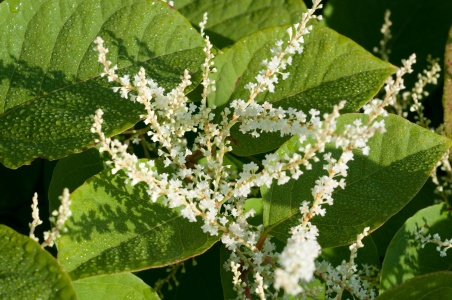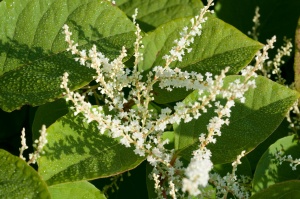Herbaceous perennial, up to 10’ tall. Hollow, reddish, arching bamboo-like stems are smooth and stout often persisting after plant dies back each year. The base of the stem above each joint is swollen and surrounded by a membranous sheath (ocrea).
Legal classification in WI: Restricted
Leaves: Alternate, egg-shaped to almost triangular, 4-6″ long, 3-4″ wide. Dark green on upper surface and pale green on lower surface.
Flowers: Blooms in late summer. Flowers are numerous, highly branched, tiny, creamy white or greenish and found where the leaf attaches to the stem (axils), near the tips of stems.
Fruits and seeds: Small, winged, triangular fruits carry very small, shiny seeds.
Roots: Plants arising from seed have a taproot up to 6′ deep. Stout, rhizomes can reach 65′ or more from parent plants and give rise to new stalks. Both plants arising from seed and rhizome also have fibrous roots.
Similar species: Giant knotweed (P. sachalinense) is also invasive, but grows up to 13′ tall with larger leaves. The two species are known to hybridize.
Ecological threat:
• Invades upland and lowland sites that are disturbed and undisturbed. Less likely to invade forested sites with a well-developed canopy. Poses a significant threat to riparian areas, where it can rapidly spread. It tolerates shade, high temperatures, high salinity, and drought.
• It can be transported to new sites as a contaminant in fill dirt or on equipment. During floods, it spreads downstream by shoot fragments, rhizomes, or occasionally by seeds. Escapees from neglected gardens and discarded cuttings are common routes of dispersal from urban areas.
• Although reported to not produce viable seed, several studies have shown that populations of knotweed in the United States can produce viable seed that readily germinate and survive in field conditions.
Treatment: Use chemical treatment.
For more information visit: http://dnr.wi.gov/topic/Invasives/fact/JapaneseKnotweed.html
(Photo source http://www.florafinder.com)

